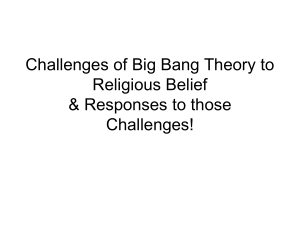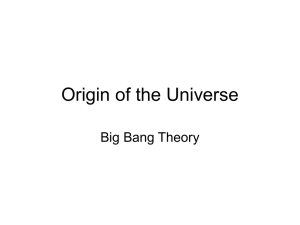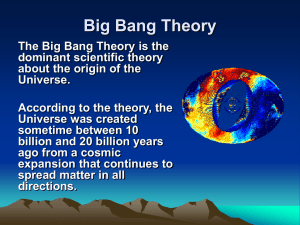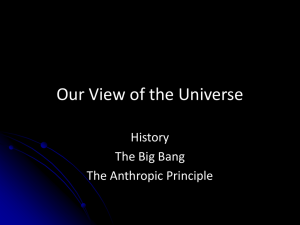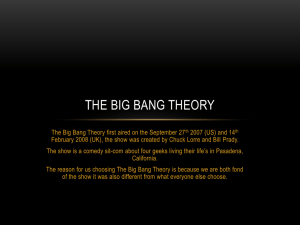Counterpoint
advertisement
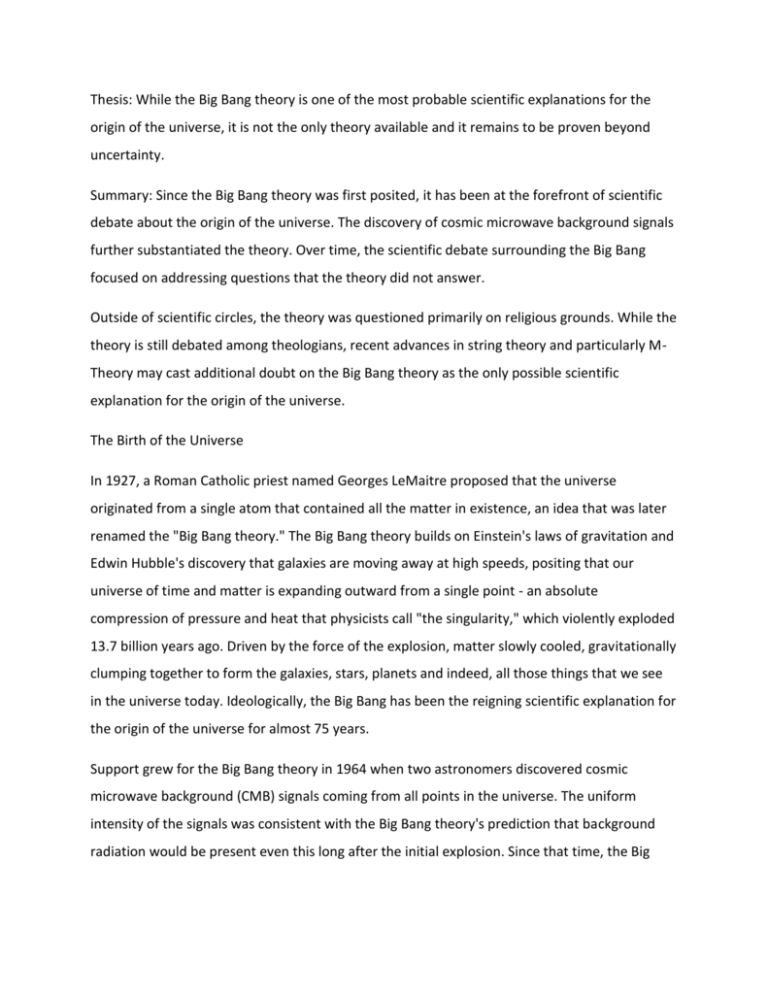
Thesis: While the Big Bang theory is one of the most probable scientific explanations for the origin of the universe, it is not the only theory available and it remains to be proven beyond uncertainty. Summary: Since the Big Bang theory was first posited, it has been at the forefront of scientific debate about the origin of the universe. The discovery of cosmic microwave background signals further substantiated the theory. Over time, the scientific debate surrounding the Big Bang focused on addressing questions that the theory did not answer. Outside of scientific circles, the theory was questioned primarily on religious grounds. While the theory is still debated among theologians, recent advances in string theory and particularly MTheory may cast additional doubt on the Big Bang theory as the only possible scientific explanation for the origin of the universe. The Birth of the Universe In 1927, a Roman Catholic priest named Georges LeMaitre proposed that the universe originated from a single atom that contained all the matter in existence, an idea that was later renamed the "Big Bang theory." The Big Bang theory builds on Einstein's laws of gravitation and Edwin Hubble's discovery that galaxies are moving away at high speeds, positing that our universe of time and matter is expanding outward from a single point - an absolute compression of pressure and heat that physicists call "the singularity," which violently exploded 13.7 billion years ago. Driven by the force of the explosion, matter slowly cooled, gravitationally clumping together to form the galaxies, stars, planets and indeed, all those things that we see in the universe today. Ideologically, the Big Bang has been the reigning scientific explanation for the origin of the universe for almost 75 years. Support grew for the Big Bang theory in 1964 when two astronomers discovered cosmic microwave background (CMB) signals coming from all points in the universe. The uniform intensity of the signals was consistent with the Big Bang theory's prediction that background radiation would be present even this long after the initial explosion. Since that time, the Big Bang theory has been continually reported as fact, despite ongoing critique and examination from within the scientific community. Controversy The doubt surrounding the Big Bang theory focuses on the belief that the evidence available at this point is complete and conclusive. As of 1919, astronomers were still questioning whether or not the universe existed beyond our own galaxy; investigations into this matter were severely limited by the quality of the telescopes available. If we've only begun to realize the true size of our universe over the last hundred years, how can we define how our universe began based solely on mathematics and our present-day technologies? It is arrogant to assert that new technologies cannot disprove our present theories. With this in mind, it is inappropriate to accept the Big Bang theory as fact and incorporate it as such into public school curricula. The debate between creationist beliefs and scientific theory most often manifests itself in arguments about Darwinian evolution. In 1999, creationists on the Kansas Board of Education voted to eliminate teaching and testing both the theory of evolution and the Big Bang theory. Their decision was ultimately overturned. In August 2006, when two conservative Republicans were voted off the board, evolution and the Big Bang made a classroom comeback. However, intelligent design achieved a small victory when, in 2008, the Louisiana Science Education Act was signed into law. The LSEA required schools in the state to foster critical thinking skills by encouraging students to question topics such as the theory of evolution, the origin of life, global warming and human cloning. The bill was opposed by the American Association for the Advancement of Science and criticized for being "anti-science" by several other prominent scientific organizations. In 1996, biochemist Michael J. Behe entered the debate against scientific theory with the publication of his book, "Darwin's Black Box: The Biochemical Challenge Against Evolution." In his work, Behe outlines a middle-ground between science and religion. He asserts that the biochemical systems present in the universe are irreducibly complex, and, therefore, serve as evidence of some form of intelligent design. Based on the work of Behe, some Christians maintain that it is possible to accept evolution and the Big Bang as likely explanations for the origin of the universe, while continuing to assert divine authorship. In regard to the match between the Big Bang theory and the Bible, it is helpful that the scientific theory asserts that neither time nor matter existed prior to the Big Bang. This is very similar to the biblical notion that God created the world from nothing (ex nihilo). The book of Hebrews states, "By faith we understand that the universe was formed at God's command, so that what is seen was not made out of what was visible" (11:13). The idea of intelligent design, then, offers a point of correlation between scientific theory and religious confession. Meanwhile, other Christians believe that the earth is quite young and that its creator intentionally included aged elements such as mountains, valleys, caverns, and even fossils at the time of the earth's creation. This theory, known as young earth creationism, is the focus of a museum in Petersburg, Kentucky, which opened in May 2007. The Creation Museum focuses on countering scientific theories such as evolution and the Big Bang, and holds to the belief that the earth is only 6,000 years old. Young earth creationists are very resistant to any scientific theories on the origin of the universe. They argue that people did not witness the creation of the universe and, therefore, should not claim to know how it all began. Similarly, the Institution for Creation Research in Texas allows students to engage in graduate-level research on the origins of life. However, the Texas Higher Education Coordination Board unanimously voted to prohibit the ICR from distributing accredited master's graduate degrees to its students in 2008. New Hypotheses While the Big Bang theory has been the dominant cosmological explanation of the origin of our universe since it displaced Albert Einstein's steady state model, it is no longer the only theory. After many years of research in the field of string theory, astronomers, physicists, and mathematicians have posited a new cosmological model called Matrix theory (M-theory). String theory postulates that the deep, subatomic structure of the universe is located in vibrating strings, not particles, as in the standard model of particle physics. These strings can be closed like loops or open like a piece of thread. Radically untestable, string theory exists in the avant- garde of cosmological science. String theorists recently split into five competing camps: three are based on superstrings and two are based on heterotic strings. Because the five theories are mathematically interconnected--each can transform into the others depending on one's approach to the underlying phenomena--a commonality has been suggested. This commonality is called M-theory. M-theory was able to unify the five string theories by positing that a new element exists in the universe: a brane (also called a p-brane or membrane). According to M-theory, our fourdimensional universe exists not absolutely but within the surface of a brane, which itself is in a much larger eleven-dimensional cavity of space-time. Meanwhile, the mathematics of M-theory postulate an infinitude of parallel universes, each existing within its own brane. On occasion, two or more of these branes might collide, their surfaces vibrating and rippling, the impact occurring at different points along their surfaces. According to M-theory proponents, these points of impact are the beginning of our "clumps of matter," not the Big Bang's explosion from an absolute singularity. The beginning singularity required by the Big Bang model is reduced from an absolute origin to a point along a line that theorists can now move forward and backward without abandoning the laws of physics, in which time remains a constant. In short, M-theory, because it can go beyond the singularity, poses a real alternative to the Big Bang's description of the origins of the universe. M-theory may gain considerable ground in the future if string-theorists like Joe Polchinki at the University of California Santa Barbara prove correct. According to the July 14, 2007 issue of "New Scientist," Polchinki may have discovered a method for testing M-theory by observing gravitational waves in the universe that may emanate from the strings and become observable via pulsars. If such tests can be done, the results may provide the evidence needed to cast additional doubt on the Big Bang theory as the only probable cause for the origin of the universe
